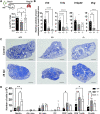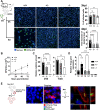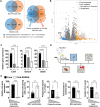Tirap controls Mycobacterium tuberculosis phagosomal acidification
- PMID: 36888688
- PMCID: PMC9994722
- DOI: 10.1371/journal.ppat.1011192
Tirap controls Mycobacterium tuberculosis phagosomal acidification
Abstract
Progression of tuberculosis is tightly linked to a disordered immune balance, resulting in inability of the host to restrict intracellular bacterial replication and its subsequent dissemination. The immune response is mainly characterized by an orchestrated recruitment of inflammatory cells secreting cytokines. This response results from the activation of innate immunity receptors that trigger downstream intracellular signaling pathways involving adaptor proteins such as the TIR-containing adaptor protein (Tirap). In humans, resistance to tuberculosis is associated with a loss-of-function in Tirap. Here, we explore how genetic deficiency in Tirap impacts resistance to Mycobacterium tuberculosis (Mtb) infection in a mouse model and ex vivo. Interestingly, compared to wild type littermates, Tirap heterozygous mice were more resistant to Mtb infection. Upon investigation at the cellular level, we observed that mycobacteria were not able to replicate in Tirap-deficient macrophages compared to wild type counterparts. We next showed that Mtb infection induced Tirap expression which prevented phagosomal acidification and rupture. We further demonstrate that the Tirap-mediated anti-tuberculosis effect occurs through a Cish-dependent signaling pathway. Our findings provide new molecular evidence about how Mtb manipulates innate immune signaling to enable intracellular replication and survival of the pathogen, thus paving the way for host-directed approaches to treat tuberculosis.
Copyright: © 2023 Belhaouane et al. This is an open access article distributed under the terms of the Creative Commons Attribution License, which permits unrestricted use, distribution, and reproduction in any medium, provided the original author and source are credited.
Conflict of interest statement
The authors have declared that no competing interests exist.
Figures






References
-
- D’Onofrio V, Monnier AA, Kremer C, Stappers MHT, Netea MG, Gyssens IC. Lesion size is associated with genetic polymorphisms in TLR1, TLR6, and TIRAP genes in patients with major abscesses and diabetic foot infections. Eur J Clin Microbiol Infect Dis. 2020;39(2):353–60. doi: 10.1007/s10096-019-03732-7 - DOI - PMC - PubMed
Publication types
MeSH terms
Substances
LinkOut - more resources
Full Text Sources
Other Literature Sources
Medical
Molecular Biology Databases

